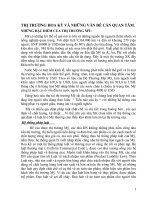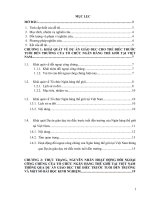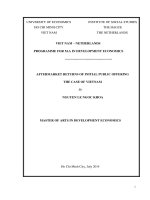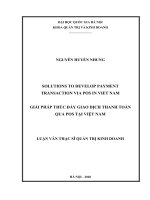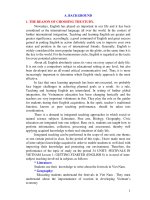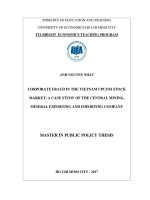Motivating more individual inventors to emerging stock market the case in viet nam
Bạn đang xem bản rút gọn của tài liệu. Xem và tải ngay bản đầy đủ của tài liệu tại đây (151.54 KB, 10 trang )
ГРОШІ, ФІНАНСИ І КРЕДИТ
299
Thai Minh Trang Phung1, Minh Tuan Nguyen2, Ngoc Khuong Mai3
MOTIVATING MORE INDIVIDUAL INVESTORS
TO EMERGING STOCK MARKETS:
THE CASE OF VIETNAM
The study proposes solutions on attracting more individual investors to participate at Vietnam
stock market. The study employs qualitative and quantitative approaches including indepth interviews with 8 investors in Ho Chi Minh City and Ha Noi Capital, who each have 10 years of experience in investing stocks in Vietnam; a group discussion to 6 brokerage managers working for top
securities corporations; and a survey of 200 individual investors trading at Vietnam stock market.
The results obtained helped the authors to develop detailed recommendations for the related public
institutions, securities corporations and individual investors.
Keywords: loss aversion; regret aversion; Vietnam stock market; individual investors.
Peer-reviewed, approved and placed: 28.07.2016.
Таі Мінь Транг Фунг, Мінь Туань Нгуєн, Нгок Хуонг Маі
МОТИВУВАННЯ ПРИВАТНИХ ІНВЕСТОРІВ ДО УЧАСТІ
НА ФОНДОВИХ РИНКАХ, ЩО РОЗВИВАЮТЬСЯ:
НА ПРИКЛАДІ В’ЄТНАМУ
У статті запропоновано варіанти, як можна залучити більше приватних інвесторів
до участі на фондовому ринку В’єтнаму. У дослідженні використано як якісні, так і кількісні підходи, зокрема: інтерв’ю з 8 інвесторами в Хошиміні та Ханої (всі з як мінімум
десятирічним досвідом інвестування у В’єтнамі); групову дискусію з 6 маклерами, що
представляють провідні фондові корпорації; а також опитування 200 приватних інвесторів, що торгують на фондовому ринку В’єтнаму. Отримані таким чином результати
допомогли авторам розробити детальні рекомендації для відповідних державних структур, фондових компаній та приватних інвесторів.
Ключові слова: несприйняття збитків; несприйняття невірних рішень; фондовий ринок
В’єтнаму; приватні інвестори.
Рис. 1. Табл. 3. Літ. 24.
Таи Минь Транг Фунг, Минь Туань Нгуен, Нгок Хуонг Маи
МОТИВИРОВАНИЕ ЧАСТНЫХ ИНВЕСТОРОВ К УЧАСТИЮ
НА РАЗВИВАЮЩИХСЯ ФОНДОВЫХ РЫНКАХ:
НА ПРИМЕРЕ ВЬЕТНАМА
В статье предложены варианты, как можно привлечь больше частных инвесторов к
участию на фондовом рынке Вьетнама. В исследовании использованы как качественные,
так и количественные подходы, в частности: интервью с 8 инвесторами в Хошимине и
Ханое (все с как минимум десятилетним опытом инвестирования во Вьетнаме); групповую дискуссию с 6 маклерами, представляющими ведущие фондовые корпорации; а также
опрос 200 частных инвесторов, торгующих на фондовом рынке Вьетнама. Полученные
таким образом результаты помогли авторам разработать детальные рекомендации для
соответствующих государственных структур, фондовых компаний и частных инвесторов.
Ключевые слова: неприятие убытков; неприятие неправильных решений; фондовый рынок
Вьетнама; частные инвесторы.
1
Corresponding author; Hoa Sen University, Ho Chi Minh City, Vietnam.
2
School of Business Administration, International University, Vietnam National University, Ho Chi Minh City, Vietnam.
3
School of Business Administration, International University, Vietnam National University, Ho Chi Minh City, Vietnam.
© Thai Minh Trang Phung, Minh Tuan Nguyen, Ngoc Khuong Mai, 2017
Electronic copy available at: />
300
ГРОШІ, ФІНАНСИ І КРЕДИТ
Introduction. Stock market is the key financial institution of a market economy.
It is a connection bridge between capital supply and demand within market economy.
A healthy and effective stock market can set up premises to exploit economic potentials, attract, and distribute capital effectively and efficiently. In order to help
Vietnam’s stock market stabilize, sustain, and develop, it is very important to protect
investors’ rights, especially Vietnamese individual investors because they have opened
1,552 mln accounts representing 99.57% domestic investors. Nonetheless, there is
only 1.72% of Vietnam population (more than 90 mln) who participate at the stock
market, thus 98.28% of Vietnam population still stays away. In other words, we still
have a lot of room to boost Vietnam’s stock market while counting on domestic individual investors.
Since the establishment in 2000, Vietnam’s stock market has experienced various up-and-downs. From 2004 to 2006, Vietnam’s stock market had an upward
trend. Market prices for almost all types of stocks increased dramatically regardless
their financial indicators. In 2006, the stock "fever" reached its peak. Vietnam became
one of the most booming stock markets with the peak of 600 in April 2006. At that
time, different investors purchased a great deal of stocks without prudential consideration of companies’ performance. However, this trend could not sustain and from
June 12th, 2006 VN-Index moved downward for the next 7 consecutive trading sessions. On July 21st, 2006 VN-index receded to its valley of 487.86 before bouncing
back to 751.77 in the last trading session of 2006. On March 12th, 2007, VN-Index
reached its highest record of 1170.67. After this day, VN-Index gradually declined to
927.02 in the last trading session of 2007. From 2008, VN-Index fluctuated but the
overall trend was downward. Majority of foreign investors turned into net sellers. This
trend remained unchanged in 2009. On February 24th, 2009, VN-Index fell into its
valley of 234.66, but on October 23rd, 2009, VN-Index reached another pinnacle of
633.21. In 2010, VN-Index fluctuated from 517.05 in the first trading session to
484.66 in the last trading session of the year. The downward trend continued into
2011, in which VN-Index dropped to 351.55 in the last trading session of the year.
The year 2012 came into investors’ minds with the notorious problem of August 21st,
which brought Vietnam’s stock market into red. This event triggered a new phase in
Vietnam’s stock market development where rumors could significantly influence
prices. VN-Index increased by 21.97% in 2013. Vietnam’s stock market closed its last
trading session with VN-Index of 504.63. In 2015, VN-Index increased by 6.1%,
while HNX-Index has decreased by 3.6% in comparison with the last trading session
in. The overall picture looks more gloomy comparing with the period of 2013–2014
where VN-Index increased by 8.13% and HNX-Index soared by 22.32% (ndh.vn).
However, what has happened at the stock market is contrary to positive macroeconomic development.
Based on the historical analysis of Vietnam’s stock market and the potential contribution of domestic individual investors it is very important to develop measures to
attract more individual domestic investors. If we can bring confidence of individual
domestic investors in Vietnam’s volatile stock market, we can contribute to healthy
and sustainable development of Vietnam’s stock market.
Literature review. Financial investment decisions are an indispensable part in
practice of any household’s financial management. Good financial decisions usually
АКТУАЛЬНІ ПРОБЛЕМИ ЕКОНОМІКИ №2(188), 2017
Electronic copy available at: />
ГРОШІ, ФІНАНСИ І КРЕДИТ
301
lead to financial satisfaction and boost family’s standard of living, while poor decisions lead to dissatisfaction and downgrading quality of life. However, people often do
not make decisions based on proper reasoning, but they are steered more by psychological factors. When they are in good moods, they tend to be too optimistic in evaluation process. They also turn into too defensive when in bad mentality. This problem becomes more severe with the increase in quantity and complexity of available
financial products, which are beyond the knowledge of ordinary people. Hence, the
process of how people make financial decisions becomes quite puzzling and affected
by rules of thumb and biases (Engelberg and Sjoberg, 2006; Lovric et al., 2008).
Traditional financial management exposes its limitation to identify key determinants
in investment decisions. In general, individual investors do not always go after rationality in financial decision making.
Why don’t individual investors participate at stock markets? L. Guiso et al.
(2008) suggested the lack of trust as the key determinant. Perception of the risk of
being cheated is consolidated from the objective characteristics of stocks and the traits
of an investor. More trusting individual investors tend to buy more stock and vice
versa. M.V. Rooij et al. (2011) discovered a positive relationship between financial literacy and stock market participation. The majority of individual investors understand
only fundamental concepts, and financial knowledge can influence how financial
decisions are made. Media also plays a very important role in stock markets.
Unusually high or low media pessimism forecasts high trading volume (Tetlock,
2007). B.M. Barber and T. Odean (2007) verified that individual investors are net buyers of attention. The overload of information at the market about potentially affordable stock can drive individual investors out of rationality when they browse a variety
of stocks to buy. Investors often first determine a choice set which draws their attention. Then their preferences set in to determine choice after attention. In addition,
investors are prone to buy and sell stocks with early names in the alphabetical order
(Jacobs and Hillert, 2016). In other words, early alphabet stocks tend to move faster
than late alphabet stock, and alphabeticity can influence stock price. Firm advertising can lure investors’ attention and affect short-term stock returns (Lou, 2014). An
increase in advertising usually gives rise to retail buying and exceptional stock returns.
Nonetheless, this is often accompanied by lower future returns. Weather can also
influence individual investors’ trading at stock markets (Schmittmann et al., 2015).
Investor sentiment which is measured as the ratio between buying and selling is higher on the days with good weather. In addition, individual investors tend to trade more
on the days with bad weather. This can be explained as there are more appealing activities which draw attention of individual investors on good weather days.
More importantly, behavioral finance is also concerned in financial investment
and considered as "a relatively new but quickly expanding filed that seeks to provide
explanations for people’s economic decisions by combining behavioral and cognitive
psychological theory with conventional economics and finance" (Baker and
Nofsinger, 2010: 3). Behavioral finance is rooted in cognitive psychology and to some
extent in neuroscience, especially focuses on how decisions are actually made,
whereas traditional finance founded on mathematical constructs of expected utility
maximization and market efficiency, emphasizes how decisions should be made normative (Yazdipour and Howard, 2010). The efficient market hypothesis assumes that
ACTUAL PROBLEMS OF ECONOMICS #2(188), 2017
302
ГРОШІ, ФІНАНСИ І КРЕДИТ
markets make rational and unbiased future prediction while behavioral finance
assumes that, under some circumstances, financial markets are informationally inefficient (Ritter, 2003). Prevalently, prospect theory developed by D. Kahneman and
A. Tversky (1974, 1979) is the theory of average behavior that "theorizes how an individual or group of individuals behaves, on average, in a world of uncertainty" (Baker
and Nofsinger, 2010: 191). Behavioral biases related to the prospect theory include
loss aversion, regret aversion, mental accounting and self-control (Kahneman and
Tversky, 1974, 1979).
Loss aversion and regret aversion are part of the original prospect theory. Loss
aversion shows that people felt a stronger impulse to prevent losses than to obtain
gains; particularly, when investors made a loss, their pain was twofold against their
pleasure when making a gain (Kahneman and Tversky, 1979). In fact, loss aversion is
a vital concept in psychology that receives a noticeable interest in analyzing economic situations. Facing loss aversion, one was unaware of taking more risks than one
would and kept unbalanced portfolios (Kahneman and Tversky, 1979). Regret aversion bias is " a more or less painful cognitive and emotional state of feeling sorry for
misfortunes, limitations, losses, transgressions, shortcomings or mistakes"
(Landman, 1993: 36). Regret aversion is represented not just the pain of financial
loss, but also painful feelings for the decision that makes loss increase more
(Brabazon, 2000: 4). More specifically, regret aversion can cause investors firstly be
too prudent in their decisions thereafter; secondly, be ashamed away excessively from
the markets which have recently decreased; thirdly, keep onto losing positions or winning positions for too long; fourthly, make them become herding investors; finally,
prefer stocks of own designated good companies (Pompian, 2006).
Some authors also suggest avoiding loss or regret aversion such as "let winners
run and cut losses" (Kahneman and Riepe, 1998) or discipline trading rules that never
change (Baker and Ricciardi, 2014). Particularly, everyone wins a few and loses a few
at a given period, but in the long run, they will come out ahead (Kahneman and
Riepe, 1998). In other words, M.M. Pompian (2006) makes the following recommendations: not to hold losing stocks for too long and use a stop loss rule; not to sell
winners too early and use a stop profit rule; not to hold onto losing investments in
companies which are in serious trouble; not to keep unbalanced portfolios; particularly, understanding standard deviation, credit rating, buy/sell/hold ratings, benefits
of asset allocation and diversification is critical for investors. J. Montier and
G.E. Strategy (2002) also emphasize that investors need to assess whether an investment still has good future prospects and suits current circumstances. For the regret
aversion bias, some researchers emphasize on trading rules: take profit and cut losses
effectively (Kahneman and Riepe, 1998; Baker and Ricciardi, 2014) or it is best to cut
losses and move on (Pompian, 2006). Apparently, investors should admit loss, confront propensities for regret and overcome the reluctance to realize losses; investors
should buy low, sell high and recognize that the first loss is the best loss; outcomes of
some other flyers that have been taken in the past; the long-term benefits of adding
risky assets to a portfolio is essential (Kahneman and Riepe, 1998; Pompian, 2006;
Baker and Ricciardi, 2014).
Based on the abovementioned problems and causes, the authors have conducted
several indepth interviews to identify solutions on how to draw more individual
АКТУАЛЬНІ ПРОБЛЕМИ ЕКОНОМІКИ №2(188), 2017
ГРОШІ, ФІНАНСИ І КРЕДИТ
303
investors into Vietnam’s stock market. Bearing in mind that the abovementioned
researches were conducted at foreign stock markets, we can see whether there is a
good match between the solutions suggested for an emerging stock market and problems/causes at older markets.
From the indepth interviews and group discussions, the investors and financial
advisors stated that loss aversion and regret aversion were mostly paid attention when
making decisions on investment. Hence, with the aim of rechecking these behavioral
biases which affected investors’ investment intention, the study proposes two
hypotheses as follows:
H1: Individual investors’ loss aversion affects stock investment intention at Vietnam
stock market.
H2: Individual investors’ regret aversion affects stock investment intention at
Vietnam stock market.
Methodology. This eight-month study employed three research techniques
including indepth interviews, group discussions, and a survey. First, indepth interviews were conducted with 8 investors who have at least 10 years of experience at the
stock market. The objective of these interviews was to explore the key factors which
stimulate investors to participate at Vietnam stock market. We contacted receptionists in securities corporations to ask for a meeting with a brokerage manager. If
accepted, we could set up appointments to present our research objectives to brokerage managers. If we successfully persuaded brokerage managers, we could receive the
lists of private investors who own at least 10 year investment experiences. Then, we
contacted these private investors randomly to set up appointments. If agreed, we had
individual face-to-face meetings which often last around 3 hours. All interviews were
fully recorded.
Second, the author organized a group discussion and invited 6 brokerage managers who have acted as investors and financial advisors. These 6 managers have
worked for prestige securities corporations in Vietnam including Ho Chi Minh City
Securities Corporation, Rong Viet Securities Corporation, Bao Viet Securities
Corporation and Investment Corporation. A group discussion lasted 4 hours. The
purpose of this discussion was to confirm the key factors proposed by investors and to
gather suggestions for the existing problems.
Third, we sent questionnaires to 230 individual investors who have been active at
Vietnam stock market. The questionnaire used five-point Likert scales (1 = totally
disagree and 5 = totally agree) of 8 items of Loss Aversion, 5 items of Regret Aversion,
and 6 items of Investment Intention. Loss Aversion, Regret Aversion were adapted
from N.M. Waweru et al. (2008), and Investment Intention from W.B. Dodds et al.
(1991) and M. Soderlund and N. Ohman (2003). Back we obtained 200 valid
responses.
Finally, the data collected were analyzed using SPSS 22.0. For the reliability test
and EFA, J.F. Hair et al. (2014) suggests that Cronbach’s alpha should be from 0.6.
Besides, KMO and Bartlett’s test should be more than 0.6 and the accepted significant level (p) less than 0.05. Initial Eigenvalue should be greater than one and cumulative percentage – no less than 50%. Factor loadings of the items on a factor are
greater than 0.3, the corrected item-total correlation index is 0.3 and the rotation
sums of squared loadings is suggested to be more than 50%.
ACTUAL PROBLEMS OF ECONOMICS #2(188), 2017
304
ГРОШІ, ФІНАНСИ І КРЕДИТ
Results.
1. The respondents’ profiles (Table 1).
Table 1. Summary of respondents’ characteristics
with the highest percentage, authors’
Characteristics
Percentage, %
Male
59.5
Age: 26–35
53.0
University degree
70.0
Income level: 6–12 mln VND
53.5
Work experience: less than 5 years
46.5
Seniority of stock investment: 1–3 years
31.5
Training courses: yes
62.0
The amount of investment: less than 100 mln VND
41.5
2. EFA results. We ran exploratory factor analysis (EFA) for Loss Aversion and
Regret Aversion. Two components, namely Regret Aversion and Loss Aversion were
extracted and explained 64.6% of the total variance. Regret Aversion (REGRET)
consisted of REGRET1, REGRET3 and LOSS8, having Cronbach’s alpha of 0.620.
Loss Aversion (LOSS) was made up of LOSS3 and LOSS4, having Cronbach’s alpha
of 0.684. We ran EFA for the dependent variable of Investment Intention.
INTEND1, INTEND2, INTEND3, INTEND4, INTEND5 and INTEND6 were
extracted into one group named INTEND with the Cronbach’s alpha of 0.923 to
explain 72.3% of the total variance. Details are shown in Table 2.
Table 2. Dependent and independent variables, authors’
Factor
Cronbach’s
Items
loadings
alpha
INTENT
0.923
I want to invest in shares next time
.916
There is a high probability I will invest shares later
.876
I intend to invest in shares next time
.870
I plan to invest in shares next time
.854
I am likely to invest in shares next time
.807
I am likely to invest in shares next time
.769
REGRET AVERSION
0.620
I keep stocks that decreased in value for a long time
.778
I keep the stocks that decreased in value and I don‘t sell them
.749
I avoid selling shares that have decreased in value and readily
.729
sell shares that have increased in value
LOSS AVERSION
0.684
I feel nervous when there are large paper losses (price drops) in
.876
my invested stocks
I am more concerned about a large loss in my stock than
.866
missing a substantial gain
3. Correlations of variables (Table 3).
As Table 3 presented, the mean of intention at 3.83 indicated that most investors
intended to invest in stocks next time. Mean of loss aversion at 3.36 and regret aver-
АКТУАЛЬНІ ПРОБЛЕМИ ЕКОНОМІКИ №2(188), 2017
ГРОШІ, ФІНАНСИ І КРЕДИТ
305
sion at 3.05, show that most investors were averse to loss and regret their decisions on
investments.
Table 3. Correlations between variables in the research model, authors’
INTENT
1
2
1. LOSS
.149*
1.00
2. REGRET
-.176*
.124*
1.00
Mean
3.83
3.36
3.05
SD
.778
.782
.690
* significance at p < 0.05.
4. Results of the regression analysis:
Investment Intention = 3.928 + 0.173 Loss Aversion – 0.223 Regret Aversion.
The above equation shows that Loss Aversion positively influences Investment
Intention but Regret Aversion negatively influences Investment Intention.
Discussion and recommendations. Through the indepth interviews and group discussion, the study explores the roles of the government in attracting more investors to
Vietnam stock market. Recently, the government has improved Vietnamese securities
law. Specifically, there were big policies promulgated in 2015 such as decree "60/NDCP" which instructed securities law; "40/ND-CP" about derivatives; circular 08 and
regulations. In general, the government has paid attention to motivate investors to the
stock market and have benefits for them. However, the government is more interested in interaction between two stocks markets in Vietnam such as HOSE and HAS,
expanding kinds of financial products, increasing the quality of listed companies,
applying securities courses in universities and colleges officially, and creating a fresh
start to investors. Securities corporations have many train courses on investment too
and update new policies timely.
Additionally, through indepth interviews and a group discussion, the study
explores the behavioral bias including loss aversion and regret aversion related to
decisions on investments. This result is consistent with E. Engelberg and L. Sjoberg
(2006), M. Lovric et al. (2008), and L. Guiso et al. (2008). Additionally, the study
mentiones investment knowledge when investing in stocks same to the ideas of
M.V. Rooij et al. (2011).
Two hypotheses proposed were satisfied with the empirical research, indepth
interviews and a group discussion. Surprisingly, the averser to loss the investors are,
the more likely they invest in stocks. A person felt nervous incurring large losses in his
portfolio or he was more sensitive toward suffering a considerable loss than missing a
substantial gain. In contrast, the more afraid of regret investors were, the less likely
they could invest in stocks. Individuals kept stocks that decreased in value for a long
time and did not sell these shares or investors avoided selling shares that had
decreased in value and readily sold shares that had increased in value.
In the group discussion, financial advisors recommended on how to avoid loss
aversion and regret aversion. These recommendations were similar to those in
(Kahneman and Riepe, 1998; Pompian, 2006; Parker, 2013; Baker and Ricciardi,
2014). To prevent negative results from loss aversion, investors should establish own
rules including cutting loss and realizing profit. When dealing with loss, assessing the
ACTUAL PROBLEMS OF ECONOMICS #2(188), 2017
306
ГРОШІ, ФІНАНСИ І КРЕДИТ
whole portfolio in which one was able to be sold soon, one was allowed to be held for
a long term, especially, considering final returns of the portfolio were so important.
More noticeably, investors had to feel calm to find solutions and did not "throw it
away". After cutting loss, if market price was in a sharp decline, investors would rebuy
this stock due to potential profit. Investors should have considered loss as a lesson
referred to own experience more than a severe failure. Interestingly, sharing problems
with their friend and investment teams made everyone less sad and more pleased.
In addition, investors should not be regretful for selling stocks too early while its
price had still gone up thereafter or holding stocks too long while its price had
declined sharply later. Significantly, everyone did not compare own profit with other
investors’ one because of different structures and opportunities, e.g., one could earn
higher profit, more than 50%, even 100% on the initial investment capital because its
product was a special product and sold in special circumstances. In the case when
stock price was increasing, investors only sold when price was declining to 10–15%
comparing with the peak point of this stock price. This decision helped avoid the
regrettable. Additionally, if actual returns on the stock exceeded the expected returns
or profit achieved from other trading segments such as real estate, interest rate for
bank deposit, investors should have liquidate because it met their expectation, satisfaction and helped avoid regret aversion. In practice, it was hard to buy stocks at a
floor price and expected to sell it at a ceiling price. Therefore, investors accepted this
degree as planned.
Recommendations to Vietnamese government, securities corporations and investors:
For Vietnamese government and State Securities Commission of Vietnam (SSC): the
Vietnamese stock market was founded 15 years ago and is an emerging market at present. First, it is necessary to have interaction between Ho Chi Minh City stock market
(HOSE) and Ha Noi stock market (HAS) to provide information timely to the public. Second, it is needed to add more financial products, e.g. derivatives, swaps,
indexes, exchanged products or accept and allow startup businesses which could raise
funds and be listed. Third, it is essential to expand securities market which they are
somewhat similar to supermarkets or entertainment domains or good playgrounds
since these places would make equal benefits for everyone and provide investors with
the opportunities for trading diversified products. Fourth, it is important to improve
Vietnamese securities law as applied to more instruments for investors, especially
short sell or clearing house. Using strict punishment for insiders or those who overstated the stock price illegally or produced dishonest information is important. Fifth,
increasing quality of listed companies, particularly correct information shown in public. Announcing information late affects investors’ decisions and causes their loss
since they could not reflect timely. Finally, it is necessary to have more courses related to securities and stock market at colleges or universities so that to teach students
to be potential individual investors and financial advisors.
For securities corporations: first, they need to organize more training courses for
investors and financial advisors. Securities corporations also should spend more time
on selecting and checking the listed companies’ legal activities profits or losses they
announce public. Besides, financial advisors need to balance the interests of securities corporations and individual investors. Professional ethics is the most crucial feature of financial advisors. Additionally, securities corporations support investors using
АКТУАЛЬНІ ПРОБЛЕМИ ЕКОНОМІКИ №2(188), 2017
307
ГРОШІ, ФІНАНСИ І КРЕДИТ
leverage. However, some securities corporations have not enough capital for investors
to use this leverage or margin. Finally, the overall number of securities corporations
in Vietnam needs to be reconsidered because many securities corporations have problems with service quality, especially with untimely consulting or quality of consulting
staff.
For investors, our experts stated that one of the most important behavioral biases investors notice were the loss aversion and regret bias since these biases much
affected investors’ decisions as well as intentions. Moreover, it is necessary to improve
investment knowledge and take part in training courses, specifically on securities
investment. It is also required to have analytical and assessment skills, predictable
ability and a logical mindset. Importantly, they should build trading forums, investing
communities and consider carefully the companies that they make decision to invest
into. They should not merely depend on information that securities corporations
announce. Finally, investors think that Vietnamese stock market is a good playground
at which everyone exposes his/her mindset, critical thinking and the ability to survive
and earn profit.
STATE
SECURITIES
COMMISSION
- Interact between HOSE and HAS and
provide information timely.
- Increase the quantity of financial products.
- Improve Vietnamese securities law.
- Increase quality of listed companies.
- Expand securities courses in universities and
colleges.
- Create a good playground comfortable for
investors.
SECURITIES
CORPORATIONS
- Offer training courses and provide
knowledge to investors and financial advisors.
- Be aware in selecting the listed companies.
- Balance of interests between securities
corporations and clients.
- Expand instruments supporting investors
such as using leverage.
- Mobilize enough capital for investors to use
leverage or margin.
- Consult clients timely.
- Reduce the total number of securities
corporations to guarantee quality.
INDIVIDUAL
INVESTORS
- Avoid biases in investment decisions such as
loss aversion and regret aversion.
- Improve investment knowledge.
- Attend training courses frequently.
- Enhance analytical and assessment skills,
predictable ability and logical mindset.
- Build trading forums and investing
communities to communicate and feel
comfortable while investing.
ATTRACT
MORE
INDIVIDUAL
INVESTORS
TO THE
STOCK
MARKET
Figure 1. Summary of solutions on attracting more individual
investors to the stock market, authors’
ACTUAL PROBLEMS OF ECONOMICS #2(188), 2017
308
ГРОШІ, ФІНАНСИ І КРЕДИТ
Conclusion. The study proposes solutions on attracting investors to Vietnam
stock market. Many new findings were identified to help attracting the investors to
this stock market as well as prevent loss aversion and regret aversion biases. However,
the study has some limitations due to small number of investors as well as financial
advisors in Ho Chi Minh city and Ha Noi Capital. Further research is suggested so
that to interview more experts in other regions of Vietnam such as Mekong delta and
Da Nang city. It is also important to have more similar quantitative researches to confirm the effect of behavioral biases on investors’ decisions at stock markets.
References:
Baker, H.K., Nofsinger, J.R. (eds.) (2010). Behavioral finance: investors, corporations, and markets.
Vol. 6. John Wiley & Sons.
Baker, H.K., Ricciardi, V. (2014). How Biases Affect Investor Behaviour. The European Financial
Review, 7–10.
Barber, B.M., Odean, T. (2008). All That Glitters: The Effect of Attention and News on the Buying
Behavior of Individual and Institutional Investors. The Review of Financial Studies, 21(2): 785–818.
Brabazon, T. (2000). Behavioural Finance: A new sunrise or a false dawn?
Dodds, W.B., Monroe, K.B., Grewal, D. (1991). Effects of price, brand, and store information on buyers' product evaluations. Journal of Marketing Research, 307–319.
Engelberg, E., Sjoberg, L. (2006). Money Attitudes and Emotional Intelligence. Journal of Applied
Social Psychology, 36: 2027–2047.
Guiso, L., Sapienza, P., Zingales, L. (2008). Trusting the Stock Market. Journal of Finance, 63(6):
2557–2600.
Hair, J.F., Black, W.C., Babin, B.J., Anderson, R.E. (2014). Multivariate data analysis. Vol. 7. UK:
Pearson Education Limited.
Jacobs, H., Hillert, A. (2016). Alphabetic Bias, Investor Recognition, and Trading Behavior. Review
of Finance, 20(2): 693–723.
Kahneman, D., Riepe, M.W. (1998). Aspects of investor psychology. The Journal of Portfolio
Management, 24(4): 52–65.
Kahneman, D., Tversky, A. (1974). Judgment under Uncertainty: Heuristics and Biases. Science,
85(4157): 1124–1131.
Kahneman, D., Tversky, A. (1979). Prospect theory: an analysis of decision-making under risk’.
Econometrica, 47(2): 263–291.
Landman, J. (1993). Regret: The persistence of the possible. New York: Oxford University Press.
Lou, D. (2014). Attracting investor attention through advertising. Review of Financial Studies, 27(6):
1797–1829.
Lovric, M., Kaymak, U., Spronk, J. (2008). The Conceptual Model of Investor Behavior. Intern rapport, ERIM Report Series, no ERS-2008-030-FA. 3000 DR Rotterdam: ERIM.
Montier, J., Strategy, G.E. (2002). Applied Behavioural Finance: Insights into irrational minds and
market. New York, USA: John Wiley & Sons Ltd.
Pompian, M.M. (2006). Behavioral finance and wealth management. How to Build Optimal
Portfolios That Account for Investor Biases. New Jersey, USA: John Wiley & Sons, Inc., Hoboken.
Ritter, J.R. (2003). Behavioral finance. Pacific-Basin Finance Journal, 11(4): 429–437.
Rooij, M.V., Lusardi, A., Alessie, R. (2011). Financial Literacy, Retirement Planning, and Household
Wealth. No. 313, DNB Working Paper.
Schmittmann, J.M., Pirschel, J., Meyer, S., Hackethal, A. (2014). The impact of weather on German
retail investors. Review of Finance, rfu020.
Soderlund, M., Ohman, N. (2003). Behavioral intentions in satisfaction research revisited. Journal of
Consumer Satisfaction, Dissatisfaction and Complaining Behavior, 16: 53–66.
Tetlock, P.C. (2007). Giving Content to Investor Sentiment: The Role of Media in the Stock Market.
Journal of Finance, 62(3): 1139–1168.
Waweru, N.M., Munyoki, E., Uliana, E. (2008). The effects of behavioral factors in investment decision-making: a survey of institutional investors operating at the Nairobi Stock Exchange. International
Journal of Business and Emerging Markets, 1(1): 24–41.
Yazdipour, R., Howard, J.A. (2010). Behavioral Finance: Application and Pedagogy in Business Education and Training. 2010): Behavioral Finance. Investors, Corporations, and Markets, New Jersey, 39–56.
АКТУАЛЬНІ ПРОБЛЕМИ ЕКОНОМІКИ №2(188), 2017

